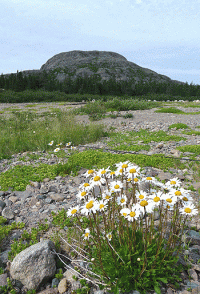Inspiring Places – Tursujuq Park
An indigenous stronghold of wild and pure beauty in Quebec’s great north – Tursujuq National Park, Canada
Background
The sheer expanse and environmental diversity of Tursujuq National Park are striking. The Park is now the largest protected area in eastern continental North America. Crisscrossed by rivers and streams and punctuated by the stunning Hudson Cuestas, it is one of the jewels of Québec’s network of protected areas.
The Park is the product of collaborative efforts among the Indigenous peoples of the region, their representative organizations, the Government of Québec, and the Kativik Regional Government. The Québec chapter of the Canadian Parks and Wilderness Society provided important support. The Park is managed by the Kativik Regional Government, which administers the territory north of the 55th parallel in Québec, Canada. Several Indigenous communities also participate in the Park’s development and operations.
The Park will protect representative portions of the Hudson Plateau and Hudson Cuestas, as well as the transition from boreal coniferous forest to arctic tundra. It captures the 170-kilometre Rivière Nastapoka — once part of a proposed hydroelectric project — and safeguards habitat of two species at risk: freshwater harbour seals and freshwater salmon
The Park area has been occupied and used by Indigenous peoples for thousands of years. Today, the Inuit and Cree continue to practice subsistence activities within the Park. Their rights to hunt, fish, and trap are set in the 1975 James Bay and Northern Québec Agreement — a land claims agreement with treaty status under the Canadian Constitution. The treaty also provides them with rights to participate in protected area planning.
Size and location
Tursujuq National Park is located in northern Québec, Canada in a region known as Nunavik (“great land” in the Inuit language). It extends east from the coast of Hudson Bay across one of the oldest portions of the Canadian Shield. It originally covered an area of approximately 15,500 square kilometers. As a result of successful efforts by Indigenous peoples (the Inuit communities of Umiujaq, Kuujjuarapik, and Inukjuak, and the Cree community of Whapmagoostui), the Kativik Regional Government, the Makivik Corporation, the Québec Government, and environmental groups, the vast majority of the Nastapoka drainage basin was added to the Park to create an area that spans an impressive 26,107 square kilometers.
Flora and Fauna
Tursujuq straddles the forest tundra sub-zone of the boreal coniferous forest and the shrub tundra sub-zone of the arctic tundra. The Park also encompasses the natural regions of the Hudson Plateau and Hudson Cuestas—ridges that give way to sheer rock facing the east but that decline gently towards the west. The Hudson Plateau features the double meteorite craters that form the Lac à l’Eau Claire which is the second largest natural lake in Québec.
Approximately 38 mammal, 131 bird, and 29 fish species are found in and around the Park. The range of environments in Tursujuq supports a diversity of bird fauna, including vulnerable species such as the Harlequin duck (Histrionicus histrionicus), Barrow’s goldeneye (Bucephala islandica), the Bald eagle (Haliaeetus leucocephalus), the Peregrine falcon (Falco peregrinus), and the Short-eared owl (Asio flammeus).
Caribou (Rangifer tarandus) is the most abundant species of land mammal. The Leaf River and George River herds, both of which are present in the Park, constitute the largest meta-population of migratory caribou in the world. It should be noted, however, that the George River herd is currently experiencing a dramatic decline.
Tursujuq is also remarkable for its marine mammals. Three species of seal are found in the Park: the Harbour seal (Phoca vitulina), the Ringed seal (Phoca hispida), and the Bearded seal (Erignathus barbatus). One subspecies of Harbour seal (Phoca vitulina mellonae) is of particular interest as it is one of the only stocks of freshwater seal that is fully landlocked. Because of its limited range and small population, the freshwater Harbour seal subspecies in Lacs des Loups Marins (Upper Seal Lake) has been classified as endangered by the Committee on the Status of Endangered Wildlife in Canada. Three separate stocks of beluga (Delphinapterus leucas) have been identified in coastal areas, including the eastern Hudson Bay beluga stock, which is a species at risk in Canada.
Challenges
Industrial activities are prohibited in the Park. However planning for hydroelectric power development and mining activities in areas close to the Park continue. Climate change and associated effects also pose a threat to biodiversity, geophysical features, and Indigenous land use. The size of the Park means that ecological processes will remain intact and help conserve valuable ecosystem services, including the storage of large amounts of carbon by forests and peat lands.
For additional information on the Park, please visit:
Nunavik Parks: http://www.nunavikparks.ca/en/parks/tursujuq/index.htm.
Canadian Parks and Wilderness Society: http://snapqc.org/en/index.php/campaigns/tursujuq.
Government of Québec: http://www.mddep.gouv.qc.ca/parcs/tursujuq/index_en.htm.
National Geographic: http://newswatch.nationalgeographic.com/2013/02/22/tursujuq/.
Protected Planet: http://www.protectedplanet.net/sites/Lacs_Guillaume_Delisleet_Lacal_Eau_Claire_National_Park.







